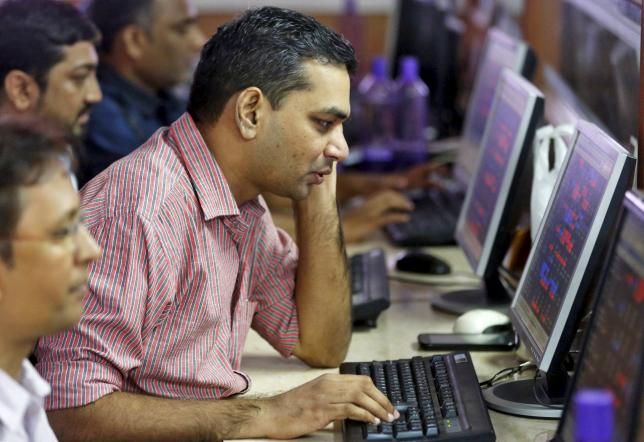Number of stocks trading above 50 times and 100 times earnings are at record highs.
When this happened in 2015 and 2016, the Sensex fell 22.6 per cent in a little over a year's time after peaking in January 2015, while it fell by 11.3 per cent in two months from its peak in September 2016.
Vishal Chhabria and Sheetal Agarwal report.

Indian stock markets have not looked back since their low on December 26, 2016, and have emerged as the top performer among major markets globally in 2017.
In a bull market such as this, almost all stocks tend to run up, irrespective of their fundamentals, which is reason enough for investors to be careful.
A key measure to identify a potential risk or reward is a stock's price-to-earnings (P/E) multiple.
This ratio is arrived at by dividing the stock price with its earnings per share or by dividing the company's market capitalisation with its net profit.
The higher the multiple, the more the price an investor is paying to buy the stock and vice versa.
At present, 81 stocks in the BSE 500 universe are trading at a P/E of 50 or more, based on their financials for the trailing 12 months ended December 2016.
Within these, 20 command a P/E of 100 to 640 times; three are trading at more than 1,000 times their earnings.
Another 56 stocks have a negative P/E, as the companies have posted a loss.
The current scenario is similar to what was seen in January 2015 and September 2016, when markets had made tops comparable to current levels.
The S&P BSE Sensex peaked at 29,682 on January 29, 2015, and at 29,045 on September 8, 2016, and at that time their P/E was 20.13 and 21.45, respectively.
The latest Sensex value is 29,461 and P/E is 22.62.
In January 2015, 75 stocks were trading at a P/E of 50 or more, while those over 100 were at 23.
Comparable numbers when Sensex peaked on September 8, 2016, were 74 and 18, respectively.
Notably, the Sensex fell 22.6 per cent in a little over a year's time after peaking in January 2015, while it fell by 11.3 per cent in two months from its peak in September 2016.
An unreasonably high P/E multiple means the stock price has run up, but the company's earnings are yet to catch up.
Most of these 100-plus P/E stocks have outperformed the BSE 500 index, with gains of 20 to 100 per cent since December 26.
One reason for the gains could be that markets tend to react first in hope of an improvement or deterioration in any company's prospects.
But it is only in hindsight that investors come to know whether the market was right or wrong.
There are many examples to prove this. Investors should, thus, be cautious while dealing in the highly valued scrips.
Coming to valuations, a caveat here is that the P/E ratio tends to vary across sectors and growth cycles.
For example, consumer food companies usually trade at a multiple of over 20, due to steady growth prospects.
We have also seen the swing in valuations of information technology and pharmaceutical companies -- from high P/E when growth rates were strong to the current low P/E due to slowdown and other concerns.
Likewise, commodity producers typically trade in single-digit P/E ratios.
This time, even as metal companies (Tata Steel, Vedanta) have posted losses in recent times, the stock returns have been phenomenal.
Nischal Maheshwari, head of institutional equities at Edelweiss Securities, explains: "Cyclicals are at the bottom of the cycle when industrials slow down; hence, they post losses. Investors should, thus, look at their enterprise value to Ebitda (operating profit) ratio; most of them are inexpensive on this front. We like Vedanta and other cyclical stocks, as recovery will be very strong."
One way of lowering the risk is by filtering out the undeserving stocks.
While there is no certainty in equity markets, the parameters to consider include the estimated earnings growth for the next one to two years, quality of company management, long-term potential to scale up a business and so forth.
A closer look at the 100-plus P/E companies reveals that earnings of 16 companies are estimated to grow by over 20 per cent annually during FY16-19.
Another 21 are expected to post profit in FY19 as compared to loss in FY16, by Bloomberg consensus data.
However, in cases where earnings estimates are available, a majority of the stocks still trade at over 20 times the two-year forward (FY19) earnings, which is not cheap. So, too, for stocks with a P/E between 50 and 100.
For stocks trading at 50-plus PEs, Gautam Sinha Roy, senior vice-president at Motilal Oswal Asset Management, has sound advice.
"Investors should only hold on to these stocks if they have very strong earnings growth visibility," Sinha Roy says. "The ones that don't deliver healthy earnings growth are more likely to witness time or price correction in their valuations."
Interestingly, there are many prominent names in the list. Many of them could be justifiably commanding high valuations, due to strong growth prospects.
Thus, experts suggest investors go a step ahead of P/E and look at the P/EG ratio, of price/earnings to growth.
This is a stock's P/E divided by the growth rate of its earnings for a specified time period.
Rakesh Arora, managing partner, Go India Advisors, says, "High-growth stocks are also valued using the P/EG ratio. This factors in the pace of growth these stocks are building into. Theoretically, if the P/EG ratio is below one, it is fine to invest at those valuations."
Image only published for representational purposes. Photograph: Reuters











